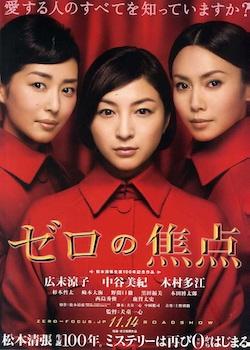Zero Focus

Directed by Isshin Inudo [犬童 一心]
2009, 131 minutes
Review by Susan Meehan
SPOILER ALERT: CONTAINS SOME PLOT DETAILS
Zero Focus, set for the most part in photogenic Kanazawa is a slick and classy film made by Isshin Inudo. It is based on the best-selling crime novel of the same name written by Seicho Matsumoto [松本 清張].
The book is very popular in Japan, and has been made into a TV drama no fewer than six times, and into a film now twice [the first movie version appeared in 1961].
This most recent film was made in 2009, to celebrate the centenary of Seicho Matsumoto’s birth, and is described by Inudo as “a new film about post-war Japan.” It is acted extremely well and boasts beautiful cinematography. Inudo admits to being more interested in the depiction of Japan in the late 1950s, and the lingering impact of the Second World War rather than in the story’s riddle itself.
The film is set in 1957. Tokyo-based Teiko, acted with great sensitivity, luminosity and subtlety by the versatile Ryoko Hirosue [広末 涼子], falls for businessman Kenichi Uhara’s calm exterior and good looks. Before long they are married and Kenichi has to return to Kanazawa to wrap up his work there. He intends to return within a week so that he can settle into married life with his new bride.
He doesn’t return.
Teiko, filled with foreboding and realising how little she knows her husband, embarks on a journey to Kanazawa to solve the mystery of his disappearance. Her only clues to his life there are two of his photographs – one is of a stately mansion and the other of a ramshackle house.
The views from the train as Teiko approaches snowy Kanazawa, skirting the sea, are breathtakingly beautiful. As Teiko meets her husband’s colleagues, the mood is achingly suspenseful and ominous, especially as a dead body has just been found at the foot of the cliffs.
Teiko meets her husband’s boss at Toyo Advertising and his wife. Each one, in separate conversations with Teiko, frustratingly says that the other knows more about Kenichi’s life in Kanazawa. They immediately seem rather suspect.
Teiko gradually begins to learn more about Kenichi who, ten years her senior, had more fully engaged with the experience of post-war, defeated Japan. He worked briefly as police officer in Tachikawa, Tokyo during the American occupation of Japan, often keeping watch over the activities of the ‘pan pan’ girls, Japanese women who would dress up in glamorous Hollywood style, hoping to catch the attention of the American GIs. Discontent at having to enforce American rules and norms, Kenichi moved on and ended up working for the most part in Kanazawa.
Kenichi is not the only one to have reinvented himself after the war. The sophisticated-looking wife of his boss at Toyo Advertising, had, in fact, been on the other side of the law, as a pan pan girl, also based in Tachikawa, Tokyo. She won’t admit to this part of her life which she finds intensely embarrassing.
When unearthed, these connections to life in occupied Japan and Tachikawa eventually lead to resolving the initial disappearance of Kenichi and the subsequent crimes. By the end of the film, six people have died.
Through discovering the mystery of Kenichi’s death and his involvement with two women from his past, whose lives have had different outcomes (remember the photographs?), Teiko comes to understand more about her husband and what drew him to her.
She realises that he has been cruelly deprived of life, just as he was about to start all over again with her. Now it is Teiko, who has to resume or restart her own life, which had been temporarily turned upside down during her sleuth-like investigations into Kenichi’s death. Ironically, had he lived there is no certainty that he would have told her about his past, so she has ended up learning more about him than may have otherwise been possible.
Photogenic Kanazawa itself is one of the film’s major protagonists. Situated by the Sea of Japan and with majestic mountains and cliffs it is incredibly beautiful. It was also the second largest city after Kyoto to survive destruction after the Second World War, so is the perfect place to begin life afresh and distance oneself from the horrors of war and its destruction.
Isshin Inudo was present at the Japan Foundation’s screening of the film at the ICA on 3 February 2013 and answered a number of questions from the admiring audience. Aware that most of his Japanese viewers would be familiar with the story itself, in making the film he focused on the film’s artistry and scenery. He also focused on the era itself.
In order to recreate old Japan for the film, much of it was shot on location in Korea, which has old buildings similar to those found in 1950s Japan and which retains a mood, reminiscent of that era.
In 1957, the year the story is set, an announcement was made by the Japanese government, stating that the postwar era was over. Perhaps, said Inudo, the story is called Zero Focus as Matsumoto was focusing on zero as the new starting point for postwar Japan from 1957 onwards.
Inudo wanted to focus on people who, even in 1957, were continuing to live under the shadow of the war, and who had been the foundation of today’s Japan. He wanted to show what suffering and sacrifices they had experienced.
In terms of gender politics, Inudo pointed out that the murdereress of the story only kills men. Admittedly, she does drive one woman to her death but this is the only victim she had any regrets about. It is almost as though she is taking revenge on male-dominated Japanese society, which had been responsible for starting the war.
A fabulous, atmospheric and thoughtful thriller!

